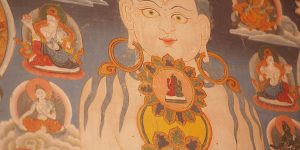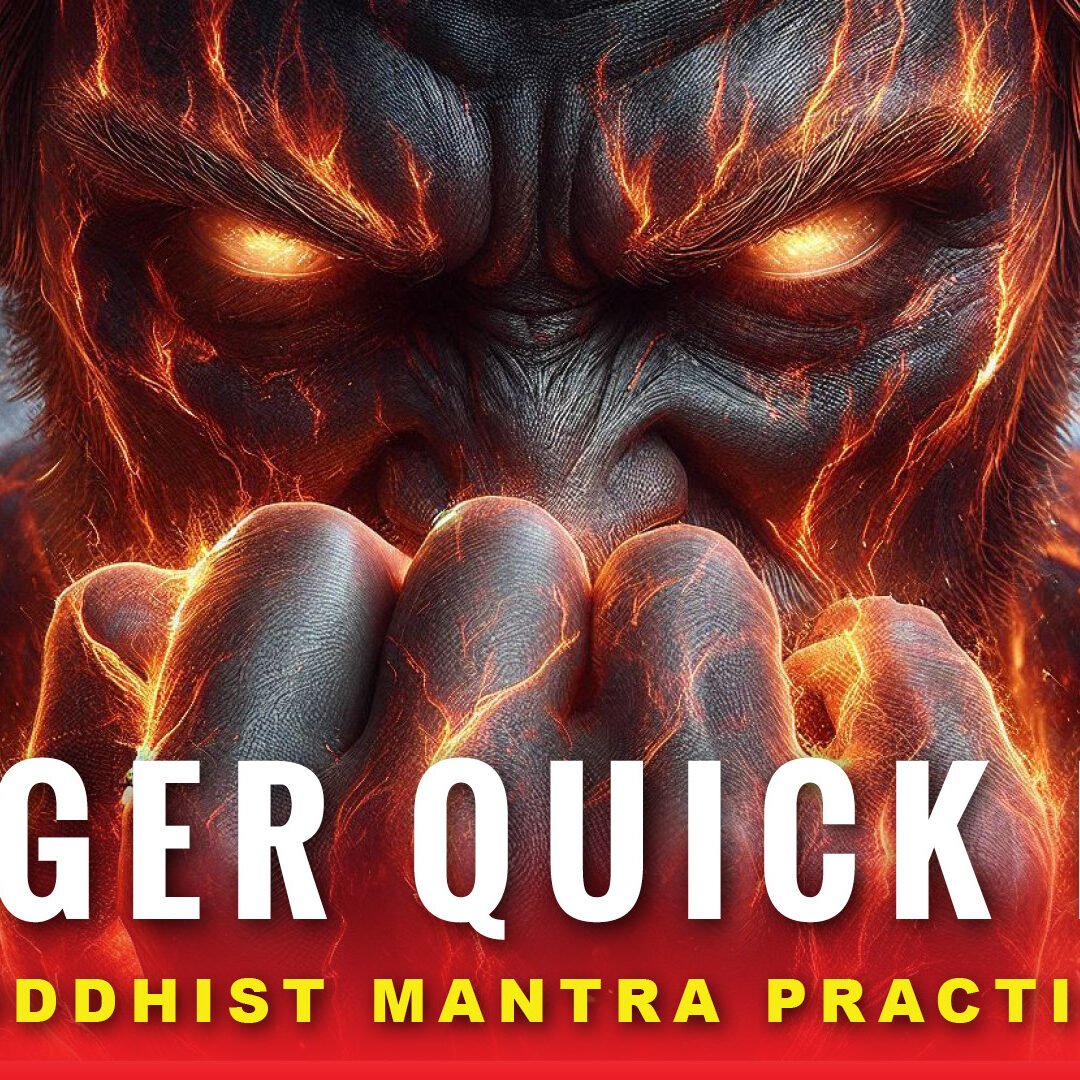VIDEO: White Umbrella Tara’s Supreme Protection: Sitatapatra Dukkar, protects against obstacles and evils
Why is Sitatapatra, Dukkar, or White Umbrella Tara, considered the most protective of all the Buddhist Enlightened Deities? Which of the 21 Taras is Sitatapatra, also known as Dukkar? Why does Sitatapatra sometimes have 2 arms, and sometimes 1000 arms — but always with the protective umbrella. What are her mantras and Dharanis? We answer these questions and more, in this short introduction to the glorious Buddhist Goddess of Protection.
Video:
NOTE: This is a slightly revised version with an editorial fix, thank you.
Don’t let the serene look of white Sitatapatra confuse you; Sitatapatra is the ultimate protective form of Mother Tara.
She can be as simple as a beautiful white goddess carrying a parasol umbrella, or as ferocious as a towering deity with 1,000 heads, 1,000 arms, and countless all-seeing eyes!
Regardless of her emanation — 2 arms or 1000 — she always holds her vast protective Parasol, a symbol of impenetrable protection — and a Dharma Wheel in her right hand, to show us that the eightfold path of the Buddha is all the protection anyone would need.
She is also Tara, a form of Sita Tara (White Tara).
Among the 21 Taras, in the Nyingma Terma tradition, she is the 19th Tara, Tara who is unconquerable and victorious.
She is a Mahayana Bodhisattva from Sutra, as well as a Vajrayana deity, and is the ultimate protection against any form of danger, obstruction and especially any super normal or supernatural threats.
Whether she is visualized in her form with 1000 arms and heads, or 2 arms, she is known as the “undefeatable one”.
VIDEO footage of two of the statues courtesy of Terma Tree. Their beautiful Sitatapatra statues can be found here>>
As a sutra practice — a teaching spoken by the Buddha — these powerful protective mantras and practices are suitable for everyone, and are very popular in many traditions of Mahayana Buddhism.
In the root Sutra, the vastly profound Śūraṅgama Sūtra, Sitatapatra originates as an emanation from Shakyamuni Buddha’s divine Ushnisha protuberance — born from the profound samadhi of the Buddha himself.
According to the root Sutra, her practice, and especially her mantra, will protect us from all harm, including supernatural threats, and ensures we will be born in Sukhavati, the Western Pureland of Amitabha.
Her Sutra practice is also for “healing illness, dispelling interferences and spirit possession, quelling disasters, and bringing auspiciousness” according to the late great teacher Lama Thubten Zopa Rinpoche.
Her practice is considered a complete practice, because of the emphasis on Samadhi, or meditation, and on embracing the Noble Eightfold Path of Shakyamuni Buddha, and the conduct of virtuous living.
Her benefits are summarized in her praise:
I salute you, exalted one!
Only mother of all the Buddhas, past, present, and future,
Your glory pervades the three worlds.
Homage to you, savioress from the evil influence of demons
and planets, obstacles and negativities
From untimely death and evil dreams,
From the dangers of poison, arms, fire, and water.
The mandala of your being is exceedingly vast.
You have a thousand heads full of innumerable mindstates,
A thousand hands holding flaming attributes.
Queen of all the mandalas of the three worlds,
Ever-present taming the evil ones,
I salute you, goddess of protection and magic, turning demons into dust!
In addition to various Sutras, Sitatapatra appears in some of Buddha’s previous life tales, known as Jatakas: The Mahaunmagga Jataka, or the life of Shakyamuni as Prince Mahosadha; and the Mugapakkha Jataka.
The easiest way to practice and invoke her protection is to chant her mantras. There is a short “heart” mantra, a medium size Dharani, a Longer Dharani and a full Heart Dharani. There is also the mantra of the 19th Tara of the 21 Taras.
Her mantra is especially powerful for protection, healing and blessings.
Sutra mantras require no empowerments, since the empowerment comes directly from Shakyamuni Buddha to us — directly into our hearts.
Her simplest mantra, according to the Sūtra is simply:
Hum ma ma hum ni svaha
The most common mantra, slightly longer, here repeated three times, is:
Om Sarva Tathagata Usnisha Sitatapatra Hum Phat Hum Ma Ma Hum Ni Svaha
OTHER VERSIONS OF MANTRA, see BuddhaWeekly.com feature: https://buddhaweekly.com/sitatapatra-or-dukkar-the-ultimate-protective-bodhisattva-goddess-form-of-mother-tara-1000-arms-or-2-arms-she-is-aparajita-the-undefeatable-one/
NOTE: There are slightly different mantras from various lineages of practices. Be guided by your own lineage and teachings. The above is the Sanskrit version from the Sutra. For example, in version written by Lobsang Dragpa at the re- quest of the renunciate Sherab Gyältsen it is written
OM SARVA TATHAGATOSHNISHA SITATAPATRE HUM PHAT HUM MAMA HUM NI SVAHA
There are other variants in other lineages, although the essence is the same.
More articles by this author

NEW MUSIC ALBUM! Four Heavenly Kings: Mantras Chanted in Sanskrit for Good Fortune, Protection, Harmony and Wisdom

4 Guardians of the World and Dharma: the Watchers of the World: the Four Heavenly Kings in Buddhism, Their Mantras and Practice
Search
Latest Features
Please support the "Spread the Dharma" mission as one of our heroic Dharma Supporting Members, or with a one-time donation.
Please Help Support the “Spread the Dharma” Mission!

Be a part of the noble mission as a supporting member or a patron, or a volunteer contributor of content.
The power of Dharma to help sentient beings, in part, lies in ensuring access to Buddha’s precious Dharma — the mission of Buddha Weekly. We can’t do it without you!
A non-profit association since 2007, Buddha Weekly published many feature articles, videos, and, podcasts. Please consider supporting the mission to preserve and “Spread the Dharma." Your support as either a patron or a supporting member helps defray the high costs of producing quality Dharma content. Thank you! Learn more here, or become one of our super karma heroes on Patreon.
Lee Kane
Author | Buddha Weekly
Lee Kane is the editor of Buddha Weekly, since 2007. His main focuses as a writer are mindfulness techniques, meditation, Dharma and Sutra commentaries, Buddhist practices, international perspectives and traditions, Vajrayana, Mahayana, Zen. He also covers various events.
Lee also contributes as a writer to various other online magazines and blogs.
















